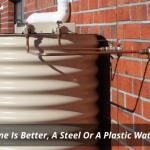
Which One Is Better, A Steel Or A Plastic Water Tank?
By Sydney Hot Water Systems|September 09, 2022
You might already be aware of stainless steel hot water tanks or plastic ones, but which one should you go for? Let us tell you why both options are great for your hot water system.
It is important to know that there are wide ranges of sizes of water storage tanks available in the market. However, all of them serve a similar purpose and it is up to you to choose the best kind according to your needs. Here we have compiled a detailed post on the benefits of each type so as to help you make an informed decision.
Both types offer good performance at high temperatures, although steel tanks last longer than plastics. Stainless steel tanks are usually cheaper to purchase since they come with a lifetime warranty, unlike plastic ones.
In addition, stainless steel is more durable than other materials such as copper and brass, so it can withstand extreme conditions.
While stainless steel is the better option in many situations, there are some disadvantages too. For example, it is very expensive to run compared to plastic tanks. But if you're looking for a tank that will last for decades, then we'd suggest going for stainless steel.
If you want something that's easy to clean, stainless steel tanks are not your best choice. Since most chemicals used for cleaning don't penetrate the surface easily, you have to use special cleaners. And the risk of rusting is higher when using acidic cleaners like vinegar, lemon juice and bleach.
When purchasing a tank, remember that it doesn't need to be big. There are small stainless steel tanks available now. In fact, you could even get an under-the-counter tank that takes up less space on top of your refrigerator.
Polybutylene is often used by itself due to its superior heat pump hot water retention capacity. It comes in two forms: solid and liquid. While the first type is cheap, it becomes brittle over time. To extend the lifespan, PB manufacturers often add a stabilizer, which increases the running cost of the product.
As mentioned before, plastics tend to break down quicker than stainless steel. If you've got children in the house, this may not be a problem, but if you do regular maintenance on the tank, it's still important to replace it once every 2 years.
The final thing to note about plastics is that they aren't recyclable. So, after disposing of the old tank, you'll need to buy and install another one. This adds to the overall costs of buying a tank for your solar hot water system or electric hot water system.
All in all, stainless steel is the clear winner here. You don't really need to worry about whether it lasts for decades or not. Plus, even though plastic tanks are cheaper, their lower durability means you'll pay extra fees to repair them.
The choice between the two is quite simple; if your household doesn’t experience frequent temperature changes, then stainless steel is probably better for you. If you live in an area where the weather gets very cold and humid, however, you might want to choose a plastic tank.
Factors to consider
If you know how often you will use hot water heaters throughout the year, then it would help you decide. You could even hire a professional to advise you based on your needs.
If a storm hits your region, plastic tanks can crack and leak. On the other hand, stainless steel tanks tend not to break under normal conditions.
Conclusion
Both materials are reliable and durable. If you pay attention to what goes into each type of tank, you should be able to find the right fit for your space. If you are concerned about the environment, you should go with stainless steel.
It's easy to clean, which means less maintenance over time. Your wallet shouldn't dictate the kind of tank you buy.
It is important to know that there are wide ranges of sizes of water storage tanks available in the market. However, all of them serve a similar purpose and it is up to you to choose the best kind according to your needs. Here we have compiled a detailed post on the benefits of each type so as to help you make an informed decision.
Both types offer good performance at high temperatures, although steel tanks last longer than plastics. Stainless steel tanks are usually cheaper to purchase since they come with a lifetime warranty, unlike plastic ones.
- Stainless steel
In addition, stainless steel is more durable than other materials such as copper and brass, so it can withstand extreme conditions.
While stainless steel is the better option in many situations, there are some disadvantages too. For example, it is very expensive to run compared to plastic tanks. But if you're looking for a tank that will last for decades, then we'd suggest going for stainless steel.
If you want something that's easy to clean, stainless steel tanks are not your best choice. Since most chemicals used for cleaning don't penetrate the surface easily, you have to use special cleaners. And the risk of rusting is higher when using acidic cleaners like vinegar, lemon juice and bleach.
When purchasing a tank, remember that it doesn't need to be big. There are small stainless steel tanks available now. In fact, you could even get an under-the-counter tank that takes up less space on top of your refrigerator.
- Plastic
Polybutylene is often used by itself due to its superior heat pump hot water retention capacity. It comes in two forms: solid and liquid. While the first type is cheap, it becomes brittle over time. To extend the lifespan, PB manufacturers often add a stabilizer, which increases the running cost of the product.
As mentioned before, plastics tend to break down quicker than stainless steel. If you've got children in the house, this may not be a problem, but if you do regular maintenance on the tank, it's still important to replace it once every 2 years.
The final thing to note about plastics is that they aren't recyclable. So, after disposing of the old tank, you'll need to buy and install another one. This adds to the overall costs of buying a tank for your solar hot water system or electric hot water system.
All in all, stainless steel is the clear winner here. You don't really need to worry about whether it lasts for decades or not. Plus, even though plastic tanks are cheaper, their lower durability means you'll pay extra fees to repair them.
The choice between the two is quite simple; if your household doesn’t experience frequent temperature changes, then stainless steel is probably better for you. If you live in an area where the weather gets very cold and humid, however, you might want to choose a plastic tank.
Factors to consider
- What size do you need?
- Costs
If you know how often you will use hot water heaters throughout the year, then it would help you decide. You could even hire a professional to advise you based on your needs.
- Safety
If a storm hits your region, plastic tanks can crack and leak. On the other hand, stainless steel tanks tend not to break under normal conditions.
- Durability
- Aesthetics
- Installation
- Water pressure
Conclusion
Both materials are reliable and durable. If you pay attention to what goes into each type of tank, you should be able to find the right fit for your space. If you are concerned about the environment, you should go with stainless steel.
It's easy to clean, which means less maintenance over time. Your wallet shouldn't dictate the kind of tank you buy.



